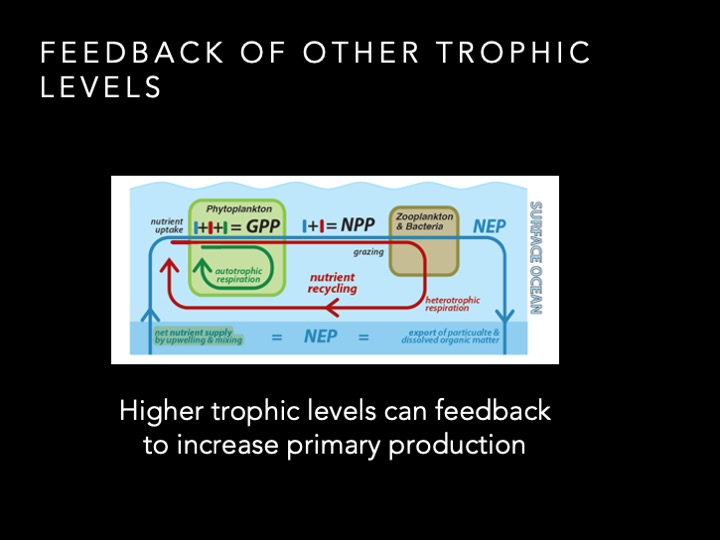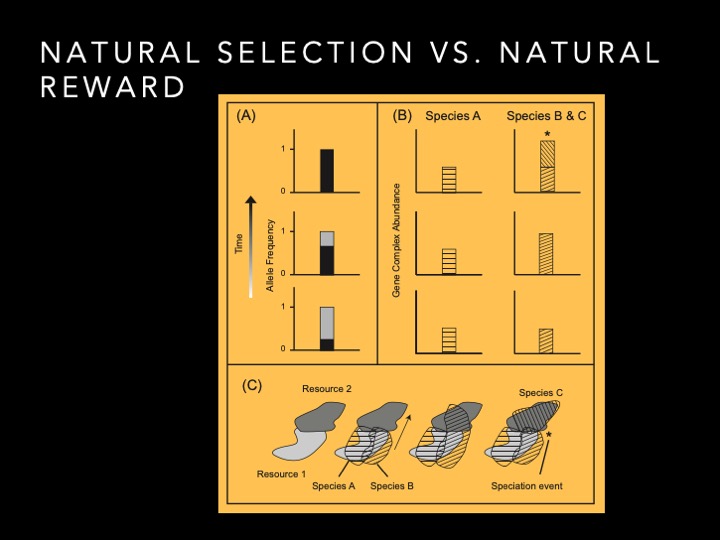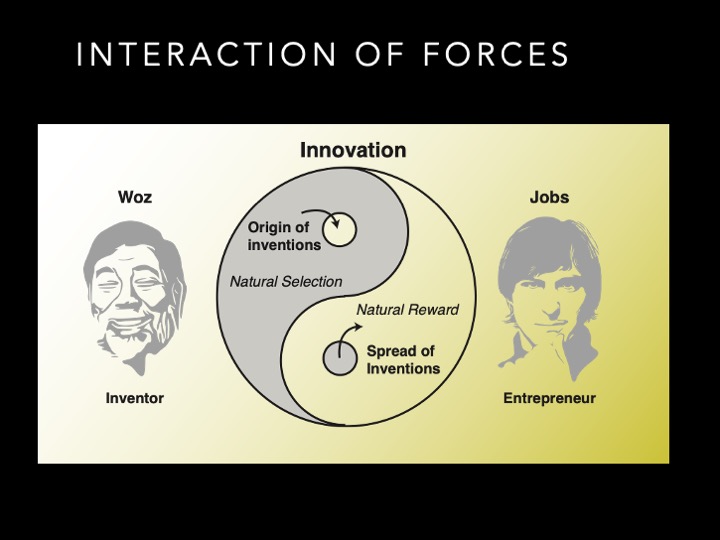UT OLLI Talk “On the Advancement of Life” Part 2 of 3
This is the second part of my talk for the Osher Lifelong Learning Institute (OLLI) at UT Austin on April 24, 2020.
Darwin had this core metaphor in his theory called the struggle for existence, which he borrowed from Malthus, but he had his own version of it. I will explain that in just a second. Before I do that, I want to give the current state of affairs on what people think is the importance of the struggle for existence.
26:00:00
Slide 22

If you open up a modern textbook on evolution, you will not read much about the struggle for existence. You will read about requirements for evolution by natural selection as heritable variation in fitness, where fitness is defined as net reproductive success. But you will not hear about the struggle for existence. Why is that?
Fisher said the struggle for existence is not important for Darwin’s logic. It was just a journalistic slogan that Darwin used to peddle his theory. This idea has been around since Fisher’s 1930 book, The Genetical Theory of Natural Selection, in which he redefined fitness from the way Darwin used it to mean adaptiveness to meaning net reproductive success. He then tried to mathematize Darwinism. He created this so-called “fundamental theorem of natural selection” and the implication was that all you needed for selection was heritable variation in fitness. Haldane quickly adopted this and had several papers on the problem of fitness being lost from populations and all these artificial dilemmas that came out of redefining fitness.
Fast forward to 1970. Richard Lewinton finally came out and explicitly stated this paradigm that everybody already accepted. He proposed two arguments to directly refute Darwin that were immediately accepted by everybody, because at this point everybody had already forgotten what Darwin said. I’ll just go through Lewinton’s arguments and disprove them.
Lewinton’s first argument for why the struggle for existence is not important is that Darwin used the struggle for existence in a large and metaphorical sense—a plant on the edge of the desert could be struggling against the drought—so resources in short supply were not important for this idea. The problem with Lewontin’s argument is that drought involves a resource limitation, water.
The second one was that if two bacteria are increasing exponentially in nutrient broth, and one doubles faster than the other, then natural selection has happened between them. That would seem to suggest that Darwin’s logic breaks down because there is an abundance of nutrients. That also can be disproved by the fact that until nutrients become limited, one strain of bacteria will never replace the other. And then the other thing is that if you then invoke a thought experiment where nutrients do become limited, what are the possibilities?
Darwin said the species is the set of individuals that use the same resources. You could have a situation where one bacterium starts feeding off the metabolic waste product of the other, in which case they would become two different species. We have seen this in the laboratory environment. Evolution by natural selection happens within the species—between the strains that are competing for the same resources. So this shows that Darwin’s argument makes sense.
00:30:00
Slide 23

It also means that the way to extend Darwin’s theory is just invoke a new struggle… On the face of it, we know there is way more power from our Sun than life on earth uses. Even of the fraction that strikes the earth’s surface and is available to do work, the vast majority of it is not used. About half of the incident solar radiation is reflected back to space or drives hydrogeologicall cycles and the other half is just converted to heat and could be used to do work. A tiny fraction is used for photosynthesis by organisms on our planet. Most energy used is by photosynthesis. Photosynthetic organisms use about eight times the amount of power right now as all of humanity. Humanity relies on fossil fuels mainly.
31:40
Slide 24

Darwin reasoned that that the whole world could become dominated by the progeny of slow breeding organisms like elephants…checks could be anything. They could be running out of resources. Or they could be predators or parasites, or natural enemies, or overcrowding. Because there is such a great potential for increase, there are going to be checks to increase…The analogy he used is that the world is like a yielding surface and…Putting in a new wedge gets rid of old wedges. So basically, if you are going to put in a new species old ones have to go extinct. Darwin is looking at the world as if it is a saturated economy already filled to the brim with living organisms.
Malthus looked at it different. Malthus knew that, looking at humans at the time, resource supplies were increasing. We were constantly innovating. But, at the same time, there was constantly a famine and a struggle for existence. So his argument was that although the resource supplies is increasing linearly, the power of the population to exponentially grow will mean that the population is constantly in a state of resource limitation. Darwin did not talk about the resource supply increasing.
The way I look at it is there is an unlimited amount of power coming from fusion reactions in stars like our sun. There is even the potential to make fusion power ourselves if we are smart enough. But, because of this vast resource of abiotic free energy in the universe, life is only limited by its ability to tap into that resource. For example, photosynthesis uses water and sunlight to create glucose.
The biotic resource supply of living organisms comes from the photosynthetic ability of the base layer of primary production. That is what allows like increases of other trophic levels and increases of biomass…Over time the total amount of resources tapped by life goes up, and these other trophic levels can also give feedback and help increase it.
00:35:12
Slide 25

Life started out just using geothermal sources of energy. There were various transitions in photosynthesis that increased its efficiency and allowed for expansions of different realms of life.
The base layer is most important for the overall expansion of life, but you have the other trophic levels coming in… in the world’s oceans, a top level of phytoplankton are limited by light and nutrients and the zooplankton eat the phytoplankton. Most of the biomass is then stored in the zooplankton, which are not photosynthetic. Constant turnover causes the wheel of primary production to spin faster… So both the innovations in the base layer and the higher trophic levels can increase primary production and be part of that struggle.
35:30
Slide 26

Okay, now the question is, with the struggle for supremacy: what is the main relevant form of competition? When Darwin talked about macroevolution, he invoked a kind of direct competition where, when a new form comes along with some general advantage, it displaces its parents, and it happens in sympatry. Where he discussed competition between larger groups, they are always in the same place at the same time.
There are a few examples of that kind of competition in macroevolution—one being the replacement of dog species, especially lone hunters, by cats in North America about 20 million years ago. You had all these dog species living in North America, some of them were lone-hunting types, and the cats migrated from Eurasia on the Bering land bridge and they came down and they were better at this lone hunting. They displaced a lot of the dogs species that were lone hunters. One of the hypotheses is that the cats can use their claws to capture prey by themselves.
36:40
Slide 27

Another example of direct competition was the angiosperms beating the gymnosperms. That looks like the angiosperms just had a really superior ability to photosynthesize—but usually there is not this big of an advantage.
What usually happens is this indirect form of competition that is more of a race…Because the dinosaurs were already there, and they were diversified and specialized, they prevented the adaptive radiation of the mammals by just being there. I called that the incumbent advantage.
But once the dinosaur were gone, the mammals quickly radiated over 10 million years to produce all these monstrous organisms that were just as big as the dinosaurs. One of the big mammals after the dinosaurs went extinct is about twice as heavy as a T-rex.
39:30
Slide 28

We know this kind of competition now from just understanding technology. If you are the first Amazon or YouTube or Facebook to come along you basically get your monopoly. You have an incumbent advantage on anybody trying to come later. That is just the way this kind of large-scale competition usually works. It is a race for the market rather than within the market.
40:00
Slide 29

Just to review: If you are a little up-and-coming firm and there is already a diversified set of firms in the market, analogous to clade of specialists, how are you going to beat these guys if you need to evolve for thousands of generations, and they are already there?
Where you have two clades that evolved on separate continents, and they come into contact, then you can have a more even kind of competition. But that does not happen very often.
40:45
Slide 33

Natural reward follows from the struggle for supremacy. The first one to get there gets this incumbent advantage, it is rewarded with a monopoly profit. How is the form of competition different? Under natural selection it is all about beating your nearest competitor. If you think about a market, it is like beating the person that is your nearest competitor in your little niche and optimizing your product. This is captured as allele frequency change. In part A, there is no overall impact on the population size. It is just the relative frequency of an allele and that is also the concept of comparative progress.
In terms of absolute progress, this is where natural reward comes in. I you tap into some new resource zone and you are the first to expand in population and get it, then you are more likely to speciate. The genes that you share then increase in overall abundance in the population. What are rewarded are the gene complexes and gene networks, or the aspects of the networks, that allow you to exploit new resource zones, and then ultimately get the incumbent advantage of specializing.
42:00
Slide 34

So the analogy I make to distinguish these roles of natural selection and natural reward is that natural selection basically works like an inventor. It does not have any foresight for the future. It only works for the immediate benefits and gradually tinkers. It can, over time, go down blind allies and create complex traits, but those complex traits could just as easily lead to extinction as success. You could adapt to an island, you could be a dodo bird, or you could become a human, or a bird or something that has radiated greatly. So, for example, a platypus has all these crazy bells and whistles on it—spurs, duckbill, and eggs—it looks like it is a contraption. A human has got its big brain, vocal box, hands and a different foot. One of them happens to work together, well another one does not. But natural selection does not do that. You have this random variation that comes from natural selection and that is the raw fodder for natural reward. The entrepreneurial function picks out the inventions that can be spread to large markets.
Steve Wozniak and Steve Jobs in the early days of Apple Computer carried out these different functions. You also see it when literary agents serve the entrepreneurial role in spreading the authors’ inventions to the markets.
Okay, this term reward has a long history and you see it being used when people are talking about the profits of innovation and entrepreneurship. Once I came up with it to describe this different force of evolution, I just saw it everywhere. People were using it in the right context.
44:00
Slide 35

To give a brief overview: under strict natural selection, you have resource limitation, a struggle for existence, natural selection, and survival of the fittest. Then, over time, through climate change and extinction, you get one thing after another. But then if you include natural reward, where natural reward is acting on the inventions that natural selection creates, and it preferentially rewards the ones that tap into new resources, then over time, you have the success of the innovative, expansion, and advancement.
00:45:12
Slide 37

I define biological progress much like an economist would define progress in terms of overall expansion, for example increase of GDP of the world economy versus the number of terrestrials species. As you can see from this figure and you have the same kind of expansive trends in our economy, as in the history of life. The difference basically is that our technological evolution right now happens about a million times as fast, which actually affords this opportunity to make this big advance on Darwin’s theory of evolution. People are now familiar with all of these long-term processes that they have witnessed throughout their lives that happen over millions of years to hundreds of millions of years in biological evolution. We are familiar now with all the necessary concepts.
I define advancement, in contrast to progress, as the ability to make more progress. So this would be something that gives you the ability to further invent, explore and discover, that would allow you to be creative or better at disseminating your creations to the markets.
By analogy, science would make progress if it makes some discoveries, but it would advance fundamentally when it has a new theory that allows it to be a more potent engine of discovery and progress. So, there are a lot of discoveries that came after Newton but then when Einstein revolutionized his theory, that created a whole new realm in which you could discover new things like black holes, quasars, gravitational waves, and light bending.
But just to give a little idea of kind of the long-term type of processes that result from natural reward and natural selection interacting, I revisit this idea of the mammals and the dinosaurs competing. You basically had to have the this big asteroid come in and kill off all these big dinosaurs before the mammals could radiate. Then when the mammals radiated, they ultimately gave rise to humans, which then tapped into new resources like fossil fuels. Mammals would be more advanced in the sense that they have all these advantages over the dinosaurs that let them explore and discover—like increased intelligence, warm blood, dentition, and better sensory abilities. A lot of these things were important for humans.
Comments on Part II in Reflection
As I explain in my paper, Natural reward drives the advancement of life, Darwin actually took two approaches to his “struggle for existence” metaphor. One assumed that world was already resource limited. The other assumed that it was not. Neither argument assumed that the resource supply was increasing.
Some people have criticized the phrase “struggle for supremacy.” To that, I would say that there is historical precedent for my phrase in biology and studies of history. It is the best phrase to convey the meaning that I intend.
I would also note that the incumbent advantage also applies in evolutionary science. Existing theories usually have an advantage the stems from the fact that they have already had time to yield an array of diversified and specialized models. Even if the models are wrong, their sophistication can convey an aura of scientific sophistication, which gives them an incumbent advantage.